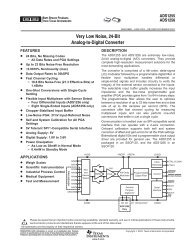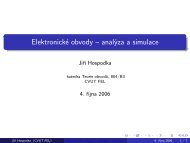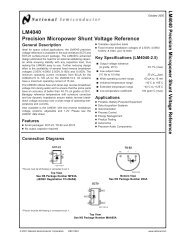LTC2410 24-Bit No Latency âΣTM ADC with Differential Input and ...
LTC2410 24-Bit No Latency âΣTM ADC with Differential Input and ...
LTC2410 24-Bit No Latency âΣTM ADC with Differential Input and ...
Create successful ePaper yourself
Turn your PDF publications into a flip-book with our unique Google optimized e-Paper software.
<strong>LTC<strong>24</strong>10</strong>APPLICATIO S I FOR30ATIOU W U Uity. Typical measured performance curves for output datarates up to 100 readings per second are shown in Figures␣27, 28, 29, 30, 31, 32, 33 <strong>and</strong> 34. In order to obtainthe highest possible level of accuracy from this converterat output data rates above 20 readings per second, theuser is advised to maximize the power supply voltage used<strong>and</strong> to limit the maximum ambient operating temperature.In certain circumstances, a reduction of the differentialreference voltage may be beneficial.<strong>Input</strong> B<strong>and</strong>widthThe combined effect of the internal Sinc 4 digital filter <strong>and</strong>of the analog <strong>and</strong> digital autocalibration circuits determinesthe <strong>LTC<strong>24</strong>10</strong> input b<strong>and</strong>width. When the internaloscillator is used <strong>with</strong> the notch set at 60Hz (F O = LOW),the 3dB input b<strong>and</strong>width is 3.63Hz. When the internaloscillator is used <strong>with</strong> the notch set at 50Hz (F O = HIGH),the 3dB input b<strong>and</strong>width is 3.02Hz. If an external conversionclock generator of frequency f EOSC is connected to theF O pin, the 3dB input b<strong>and</strong>width is 0.236 • 10 –6 • f EOSC .Due to the complex filtering <strong>and</strong> calibration algorithmsutilized, the converter input b<strong>and</strong>width is not modeled veryaccurately by a first order filter <strong>with</strong> the pole located at the3dB frequency. When the internal oscillator is used, theshape of the <strong>LTC<strong>24</strong>10</strong> input b<strong>and</strong>width is shown in Figure␣35 for F O = LOW <strong>and</strong> F O = HIGH. When an externaloscillator of frequency f EOSC is used, the shape of the<strong>LTC<strong>24</strong>10</strong> input b<strong>and</strong>width can be derived from Figure␣ 35,F O = LOW curve in which the horizontal axis is scaled byf EOSC /153600.The conversion noise (800nV RMS typical for V REF = 5V)can be modeled by a white noise source connected to anoise free converter. The noise spectral density is62.75nV√Hz for an infinite b<strong>and</strong>width source <strong>and</strong>86.1nV√Hz for a single 0.5MHz pole source. From thesenumbers, it is clear that particular attention must be givento the design of external amplification circuits. Suchcircuits face the simultaneous requirements of very lowb<strong>and</strong>width (just a few Hz) in order to reduce the outputreferred noise <strong>and</strong> relatively high b<strong>and</strong>width (at least500kHz) necessary to drive the input switched-capacitornetwork. A possible solution is a high gain, low b<strong>and</strong>widthamplifier stage followed by a high b<strong>and</strong>width unity-gainbuffer.OFFSET ERROR (ppm OF V REF )5004504003503002502001501005000 10 20 30 40 50 60 70 80 90 100OUTPUT DATA RATE (READINGS/SEC)<strong>24</strong>10 F27Figure 27. Offset Error vs Output Data Rate <strong>and</strong> Temperature+FS ERROR (ppm OF VREF)V CC = 5VREF + = 5VREF – = GNDV INCM = 2.5VV IN = 0VF O = EXTERNAL OSCILLATORT A = 85°CT A = 25°C0 10 20 30 40 50 60 70 80 90 100OUTPUT DATA RATE (READINGS/SEC)Figure 28. +FS Error vs Output Data Rate <strong>and</strong> Temperature–FS ERROR (ppm OF V REF )700060005000400030002000100000–1000–2000–3000–4000–5000–6000–7000V CC = 5VREF + = 5VREF – = GNDIN + = 3.75VIN – = 1.25VF O = EXTERNAL OSCILLATORT A = 25°CT A = 85°CT A = 85°CT A = 25°CV CC = 5VREF + = 5VREF – = GNDIN + = 1.25VIN – = 3.75VF O = EXTERNAL OSCILLATOR<strong>24</strong>10 F280 10 20 30 40 50 60 70 80 90 100OUTPUT DATA RATE (READINGS/SEC)<strong>24</strong>10 F29Figure 29. –FS Error vs Output Data Rate <strong>and</strong> Temperature






